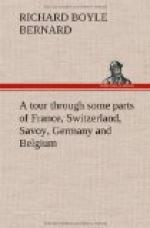Great preparations were making at Frankfort to celebrate the anniversary of the glorious battle of Leipsig; and I was present at the inspection of about 6,000 men, preparatory to the great review on the eighteenth. There were many ladies present, and, although the weather was far from being warm, yet few of them wore bonnets. In general their hair was rolled round their heads.
Not being able to delay any longer in Frankfort, I took the road to Mayence, and passed through the large village of Hochheim, which contains 300 families. It was formerly the property of the chapter of Mayence, but its future destiny is at present undecided. From this place is derived the English name of Hock, which is applied to all the wine of the Rhingau. There are vast numbers of vineyards and fruit-trees around the village; and, from a hill above it, is seen the junction of the Mayn with the Rhine, in the midst of this rich country. The waters of the Mayn are of a dark hue, but do not, however, succeed in obscuring altogether the colour which the Rhine brings from Switzerland, and which I had so much admired at Schaffhausen. From the bridge of boats, which is 1,400 feet in length, and which forms the communication between Mayence and Cassel, one sees the Rhine forced by mountains to change its northerly direction, and, after forming some small islands it runs for some distance to the eastward. The mountains, which change the course of this vast river, form the Rhingau so celebrated for its wines. That of the village of Rudesheim is particularly noted for producing the best wine of the Rhingau, and consequently of Germany. The French had expended vast sums on the fortifications of Cassel and Mayence, and rendered the latter one of the keys of Germany, as well from its strength as from its situation. They had always a great depot here, which considerably benefited the city; the loss of that advantage is much regretted.
When seen from the bridge (which is longer than that of Westminster) Mayence presents a striking appearance on account of its spires, and the vessels that line its quay, which presents a scene of considerable activity. On the customhouse were displayed the flags of Austria, Prussia, and Bavaria; but to which of those powers the city is to be subject is still undetermined. On the river are a great number of corn-mills, necessary where there is so great a garrison. The barracks are handsome, and on a large scale. The general appearance of the interior of Mayence is bad. The streets are in general narrow, dirty, and intricate. Near the castle are some good houses.
The cathedral is one of the largest buildings in Germany, It has suffered considerably in the late wars, and is now covered with wood. Its appearance is not, however, very striking, and it is surrounded with mean houses. I observed that a statue, “a l’Empereur” is still standing in front of one of the houses in this city. Its population is said to be 26,000. The inhabitants, for a considerable distance round Mayence, subsist principally by agriculture. They export their grain on the Rhine to Switzerland. They have abundance of vegetables, and the lower orders live a good deal on cabbage, which is here of a large size.




